Practicalities of Incorporating 3D Laser Scanning with BIM in Live Construction Projects: A Case Study
Abstract
:1. Introduction
2. Materials and Methods
3. Literature Review
3.1. Origins and Evolution of Building Information Modelling (BIM)
3.2. Data Acquisition Techniques
3.3. Incorporating 3D Laser Scanning into BIM
3.4. Problem Statement
4. Application of Incorporated 3D Laser Scanning and BIM in Live Building Projects
4.1. Data Acquisition
4.2. Spatial Modelling Using Integrated Advanced Technologies
5. Discussion
6. Conclusion
Author Contributions
Funding
Data Availability Statement
Conflicts of Interest
References
- Chatzimichailidou, M.; Ma, Y. Using BIM in the safety risk management of modular construction. Saf. Sci. 2022, 154, 105852. [Google Scholar] [CrossRef]
- Wang, J.; Zhang, S.; Fenn, P.; Luo, X.; Liu, Y.; Zhao, L. Adopting BIM to Facilitate Dispute Management in the Construction Industry: A Conceptual Framework Development. J. Constr. Eng. Manag. 2023, 149, 03122010. [Google Scholar] [CrossRef]
- Ghansah, F.A.; Lu, W. Responses to the COVID-19 pandemic in the construction industry: A literature review of academic research. Constr. Manag. Econ. 2023, 41, 781–803. [Google Scholar] [CrossRef]
- Goedert, J.D.; Meadati, P. Integrating Construction Process Documentation into Building Information Modeling. J. Constr. Eng. Manag. 2008, 134, 509–516. [Google Scholar] [CrossRef]
- Eadie, R.; Browne, M.; Odeyinka, H.; McKeown, C.; McNiff, S. BIM implementation throughout the UK construction project lifecycle: An analysis. Autom. Constr. 2013, 36, 145–151. [Google Scholar] [CrossRef]
- Cheng, T.; Teizer, J. Real-time resource location data collection and visualization technology for construction safety and activity monitoring applications. Autom. Constr. 2013, 34, 3–15. [Google Scholar] [CrossRef]
- Chan, D.W.M.; Olawumi, T.O.; Ho, A.M.L. Perceived benefits of and barriers to Building Information Modelling (BIM) implementation in construction: The case of Hong Kong. J. Build. Eng. 2019, 25, 100764. [Google Scholar] [CrossRef]
- Sadeghineko, F.; Kumar, B. Facilitating Information Exchange for 3D Retrofit Models of Existing Assets Using Semantic Web Technologies. In Enabling the Development and Implementation of Digital Twins, Proceedings of the 20th International Conference on Construction Application of Virtual Reality, Online, 30 September 2020–2 October 2020; Dawood, N., Rahimian, F.P., Seyedzadeh, S., Sheikhkhoshkar, M., Eds.; Teesside University Press: Middlesbrough, UK, 2020; pp. 358–371. [Google Scholar]
- Amin, K.F.; Abanda, F.H. Building Information Modelling Plan of Work for Managing Construction Projects in Egypt. J. Constr. Dev. Ctries. 2019, 24, 23–61. [Google Scholar] [CrossRef]
- Mahdjoubi, L.; Moobela, C.; Laing, R. Providing real-estate services through the integration of 3D laser scanning and building information modelling. Comput. Ind. 2013, 64, 1272–1281. [Google Scholar] [CrossRef]
- Kavaliauskas, P.; Fernandez, J.B.; McGuinness, K.; Jurelionis, A. Automation of Construction Progress Monitoring by Integrating 3D Point Cloud Data with an IFC-Based BIM Model. Buildings 2022, 12, 1754. [Google Scholar] [CrossRef]
- Ayat, M.; Kang, C.W. Effects of the COVID-19 pandemic on the construction sector: A systemized review. Eng. Constr. Archit. Manag. 2021, 30, 734–754. [Google Scholar] [CrossRef]
- Li, Z.; Jin, Y.; Li, W.; Meng, Q.; Hu, X. Impacts of COVID-19 on construction project management: A life cycle perspective. Eng. Constr. Archit. Manag. 2022, 30, 3357–3389. [Google Scholar] [CrossRef]
- Barlish, K.; Sullivan, K. How to measure the benefits of BIM—A case study approach. Autom. Constr. 2012, 24, 149–159. [Google Scholar] [CrossRef]
- Khoshfetrat, R.; Sarvari, H.; Chan, D.W.M.; Rakhshanifar, M. Critical risk factors for implementing building information modelling (BIM): A Delphi-based survey. Int. J. Constr. Manag. 2020, 22, 2375–2384. [Google Scholar] [CrossRef]
- Sacks, R.; Girolami, M.; Brilakis, I. Building Information Modelling, Artificial Intelligence and Construction Tech. Dev. Built Environ. 2020, 4, 100011. [Google Scholar] [CrossRef]
- Leite, F.; Akcamete, A.; Akinci, B.; Atasoy, G.; Kiziltas, S. Analysis of modeling effort and impact of different levels of detail in building information models. Autom. Constr. 2011, 20, 601–609. [Google Scholar] [CrossRef]
- Zhang, L.; Chu, Z.; He, Q.; Zhai, P. Investigating the Constraints to Buidling Information Modeling (BIM) Applications for Sustainable Building Projects: A Case of China. Sustainability 2019, 11, 1896. [Google Scholar] [CrossRef]
- Borkowski, A.S. A Literature Review of BIM Definitions: Narrow and Broad Views. Technologies 2023, 11, 176. [Google Scholar] [CrossRef]
- Almujibah, H. Assessment of Building Information Modeling (BIM) as a Time and Cost-Saving Construction Management Tool: Evidence from Two-Story Villas in Jeddah. Sustainability 2023, 15, 7354. [Google Scholar] [CrossRef]
- Nur Sholeh, M.; Fauziyah, S.; Radian Khasani, R. Effect of Building Information Modeling (BIM) on reduced construction time-costs: A case study. E3S Web Conf. 2020, 202, 02012. [Google Scholar] [CrossRef]
- EL Mounla, K.; Beladjine, D.; Beddiar, K.; Mazari, B. Lean-BIM Approach for Improving the Performance of a Construction Project in the Design Phase. Buildings 2023, 13, 654. [Google Scholar] [CrossRef]
- Westiing, F.A.; Abbas, R.; Skinner, C.; Hanus-Smith, M.; Harris, A.; Kirchner, N. Applications of LiDAR for Productivity Improvement on Construction Projects: Case Studies from Active Sites. In Proceedings of the ISARC. Proceedings of the International Symposium on Automation and Robotics in Construction; IAARC Publications: Oulu, Finland, 2020; Volume 37, pp. 353–361. [Google Scholar]
- Wang, Q.; Qian, P.; Liu, Y.; Li, T.; Yang, L.; Yang, F. Geometric Accuracy Evaluation Method for Subway Stations Based on 3D Laser Scanning. Appl. Sci. 2022, 12, 9535. [Google Scholar] [CrossRef]
- Palčák, M.; Kudela, P.; Fandáková, M.; Kordek, J. Utilization of 3D Digital Technologies in the Documentation of Cultural Heritage: A Case Study of the Kunerad Mansion (Slovakia). Appl. Sci. 2022, 12, 4376. [Google Scholar] [CrossRef]
- Li, H.; Zhang, C.; Song, S.; Demirkesen, S.; Chang, R. Improving Tolerance Control on Modular Construction Project with 3D Laser Scanning and BIM: A Case Study of Removable Floodwall Project. Appl. Sci. 2020, 10, 8680. [Google Scholar] [CrossRef]
- Tan, Y.; Li, S.; Wang, Q. Automated Geometric Quality Inspection of Prefabricated Housing Units Using BIM and LiDAR. Remote Sens. 2020, 12, 2492. [Google Scholar] [CrossRef]
- Lawani, K.; Sadeghineko, F.; Tong, M.; Bayraktar, M. Methodology for retrospectively developing a BIM model from point cloud scans using ongoing building project as case study. J. Eng. Des. Technol. 2024. [Google Scholar] [CrossRef]
- Sadeghineko, F.; Kumar, B. Development of Semantically Rich 3D Retrofit Models. J. Comput. Civ. Eng. 2020, 34, 04020039. [Google Scholar] [CrossRef]
- Sadeghineko, F.; Kumar, B.; Chan, W. A Semantic Web-Based Approach for Generating Parametric Models Using RDF. In Advanced Computing Strategies for Engineering; Springer International Publishing: Berlin/Heidelberg, Germany, 2018; pp. 361–377. [Google Scholar] [CrossRef]
- Sadeghineko, F.; Kumar, B.; Chan, W. Employment of Semantic Web Technologies for Capturing Comprehensive Parametric Building Models. In Advances in Informatics and Computing in Civil and Construction Engineering; Springer International Publishing: Berlin/Heidelberg, Germany, 2018; pp. 111–122. [Google Scholar] [CrossRef]
- Sutherland, I.E. Sketchpad: A man-machine graphical communication system. In Proceedings of the Spring Joint Computer Conference on—AFIPS ’63 (Spring), Detroit, MI, USA, 21–23 May 1963; ACM Press: New York, NY, USA, 1963. [Google Scholar] [CrossRef]
- Eastman, C. The use of computers instead of drawings in building design. AIA J. 1975, 63, 46–50. [Google Scholar]
- Suermann, P.C.; Issa, R.R. The US National Building Information Modeling Standard. In Advances in Civil and Industrial Engineering; IGI Global: Hershey, PA, USA, 2010; pp. 138–154. [Google Scholar] [CrossRef]
- Borkowski, A.S. Evolution of BIM: Epistemology, genesis and division into periods. J. Inf. Technol. Constr. 2023, 28, 646–661. [Google Scholar] [CrossRef]
- Adán, A.; Quintana, B.; Prieto, S.; Bosché, F. An autonomous robotic platform for automatic extraction of detailed semantic models of buildings. Autom. Constr. 2020, 109, 102963. [Google Scholar] [CrossRef]
- Zhang, D.; Liu, T.; Li, S.; Luo, H.; Ding, G.; Su, Z.; Xie, C.; Zhang, S.; Feng, P. Three-dimensional laser scanning for large-scale as-built surveying of 2022 Beijing Winter Olympic Speed Skating Stadium: A case study. J. Build. Eng. 2022, 59, 105075. [Google Scholar] [CrossRef]
- Tang, X.; Wang, M.; Wang, Q.; Guo, J.; Zhang, J. Benefits of Terrestrial Laser Scanning for Construction QA/QC: A Time and Cost Analysis. J. Manag. Eng. 2022, 38, 05022001. [Google Scholar] [CrossRef]
- Sharif, M.M.; Chuo, S.; Haas, C.T. Rapid 3D Quality Control in Prefabrication Using a 3D Digital-Templates Framework. J. Constr. Eng. Manag. 2022, 148, 04022117. [Google Scholar] [CrossRef]
- Liu, J.; Xu, D.; Hyyppa, J.; Liang, Y. A Survey of Applications with Combined BIM and 3D Laser Scanning in the Life Cycle of Buildings. IEEE J. Sel. Top. Appl. Earth Obs. Remote Sens. 2021, 14, 5627–5637. [Google Scholar] [CrossRef]
- Mellado, F.; Wong, P.F.; Amano, K.; Johnson, C.; Lou, E.C.W. Digitisation of existing buildings to support building assessment schemes: Viability of automated sustainability-led design scan-to-BIM process. Archit. Eng. Des. Manag. 2019, 16, 84–99. [Google Scholar] [CrossRef]
- Valero, E.; Bosché, F.; Bueno, M. Laser scanning for BIM. J. Inf. Technol. Constr. 2022, 27, 486–495. [Google Scholar] [CrossRef]
- Ham, N.; Lee, S.H. Empirical Study on Structural Safety Diagnosis of Large-Scale Civil Infrastructure Using Laser Scanning and BIM. Sustainability 2018, 10, 4024. [Google Scholar] [CrossRef]
- Nguyen, T.A.; Do, S.T.; Le-Hoai, L.; Nguyen, V.T.; Pham, T.A. Practical workflow for cultural heritage digitalization and management: A case study in Vietnam. Int. J. Constr. Manag. 2022, 23, 2305–2319. [Google Scholar] [CrossRef]
- Qiu, Q.; Wang, M.; Guo, J.; Liu, Z.; Wang, Q. An adaptive down-sampling method of laser scan data for scan-to-BIM. Autom. Constr. 2022, 135, 104135. [Google Scholar] [CrossRef]
- Aricò, M.; Brutto, M.L. From scan-to-BIM to heritage building information modelling for an ancient Arab-Norman church. Int. Arch. Photogramm. Remote Sens. Spat. Inf. Sci. 2022, XLIII-B2-2022, 761–768. [Google Scholar] [CrossRef]
- Wu, Z.; Chen, C.; Cai, Y.; Lu, C.; Wang, H.; Yu, T. BIM-Based Visualization Research in the Construction Industry: A Network Analysis. Int. J. Environ. Res. Public Health 2019, 16, 3473. [Google Scholar] [CrossRef]
- Becerik-Gerber, B.; Jazizadeh, F.; Li, N.; Calis, G. Application Areas and Data Requirements for BIM-Enabled Facilities Management. J. Constr. Eng. Manag. 2012, 138, 431–442. [Google Scholar] [CrossRef]
- Wang, J.; Yi, T.; Liang, X.; Ueda, T. Application of 3D Laser Scanning Technology Using Laser Radar System to Error Analysis in the Curtain Wall Construction. Remote Sens. 2022, 15, 64. [Google Scholar] [CrossRef]
- Valero, E.; Mohanty, D.D.; Ceklarz, M.; Tao, B.; Bosche, F.; Giannakis, G.I.; Fenz, S.; Katsigarakis, K.; Lilis, G.N.; Rovas, D.; et al. An Integrated Scan-to-BIM Approach for Buildings Energy Performance Evaluation and Retrofitting. In Proceedings of the International Symposium on Automation and Robotics in Construction (IAARC). International Association for Automation and Robotics in Construction (IAARC), Dubai, United Arab Emirates, 2–4 November 2021. ISARC2021. [Google Scholar] [CrossRef]
- He, Y.; Liang, B.; Yang, J.; Li, S.; He, J. An Iterative Closest Points Algorithm for Registration of 3D Laser Scanner Point Clouds with Geometric Features. Sensors 2017, 17, 1862. [Google Scholar] [CrossRef] [PubMed]
- Zhang, S.; Sulankivi, K.; Kiviniemi, M.; Romo, I.; Eastman, C.M.; Teizer, J. BIM-based fall hazard identification and prevention in construction safety planning. Saf. Sci. 2015, 72, 31–45. [Google Scholar] [CrossRef]
- Ding, Z.; Sun, Y.; Xu, S.; Pan, Y.; Peng, Y.; Mao, Z. Recent Advances and Perspectives in Deep Learning Techniques for 3D Point Cloud Data Processing. Robotics 2023, 12, 100. [Google Scholar] [CrossRef]
- Moselhi, O.; Bardareh, H.; Zhu, Z. Automated Data Acquisition in Construction with Remote Sensing Technologies. Appl. Sci. 2020, 10, 2846. [Google Scholar] [CrossRef]
- Maalek, R.; Lichti, D.D.; Ruwanpura, J.Y. Automatic Recognition of Common Structural Elements from Point Clouds for Automated Progress Monitoring and Dimensional Quality Control in Reinforced Concrete Construction. Remote Sens. 2019, 11, 1102. [Google Scholar] [CrossRef]
- Schönfelder, P.; Aziz, A.; Faltin, B.; König, M. Automating the retrospective generation of As-is BIM models using machine learning. Autom. Constr. 2023, 152, 104937. [Google Scholar] [CrossRef]
- Ivson, P.; Moreira, A.; Queiroz, F.; Santos, W.; Celes, W. A Systematic Review of Visualization in Building Information Modeling. IEEE Trans. Vis. Comput. Graph. 2020, 26, 3109–3127. [Google Scholar] [CrossRef]
- Durdyev, S.; Dehdasht, G.; Mohandes, S.R.; Edwards, D.J. Review of the Building Information Modelling (BIM) Implementation in the Context of Building Energy Assessment. Energies 2021, 14, 8487. [Google Scholar] [CrossRef]
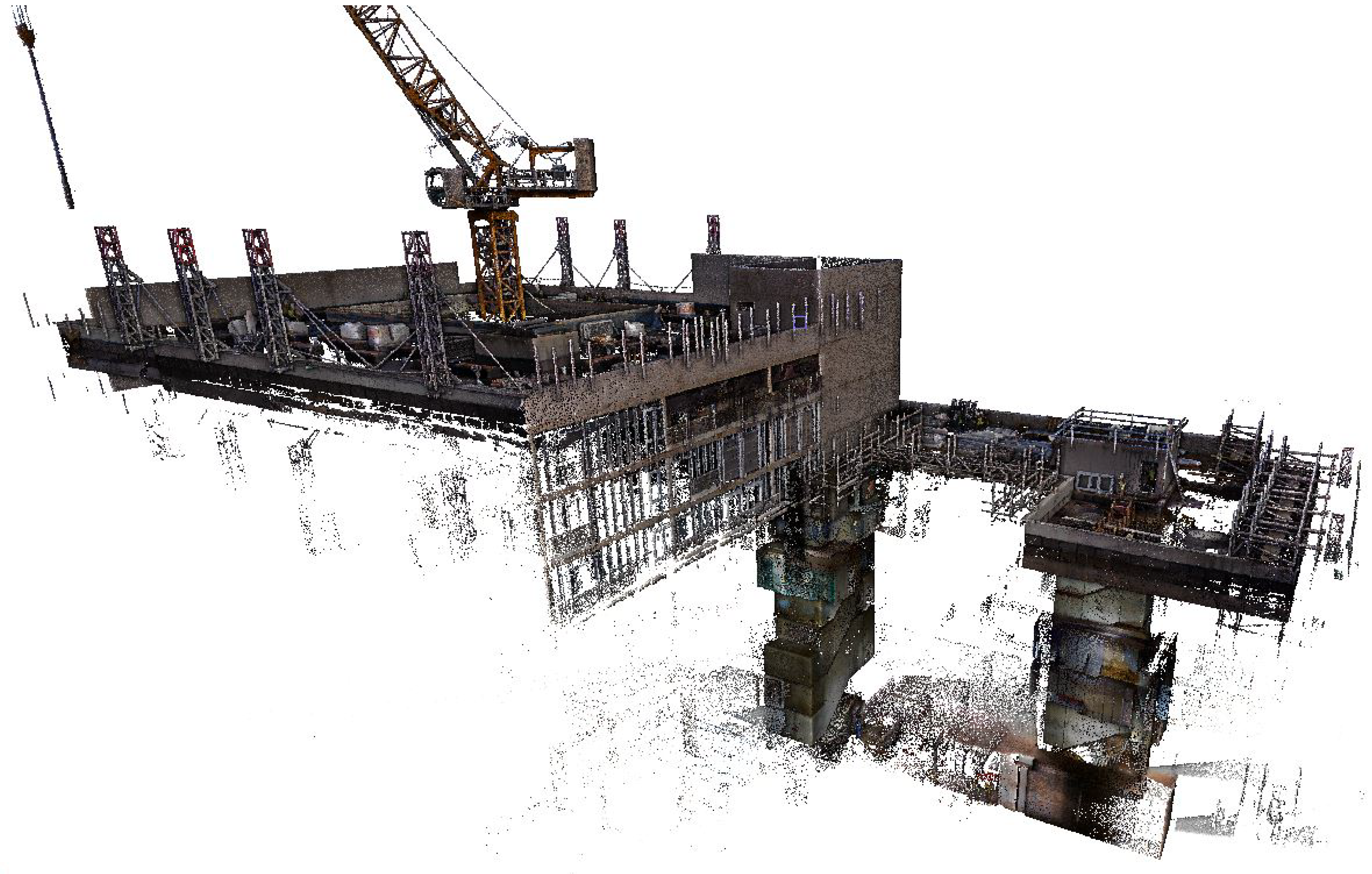

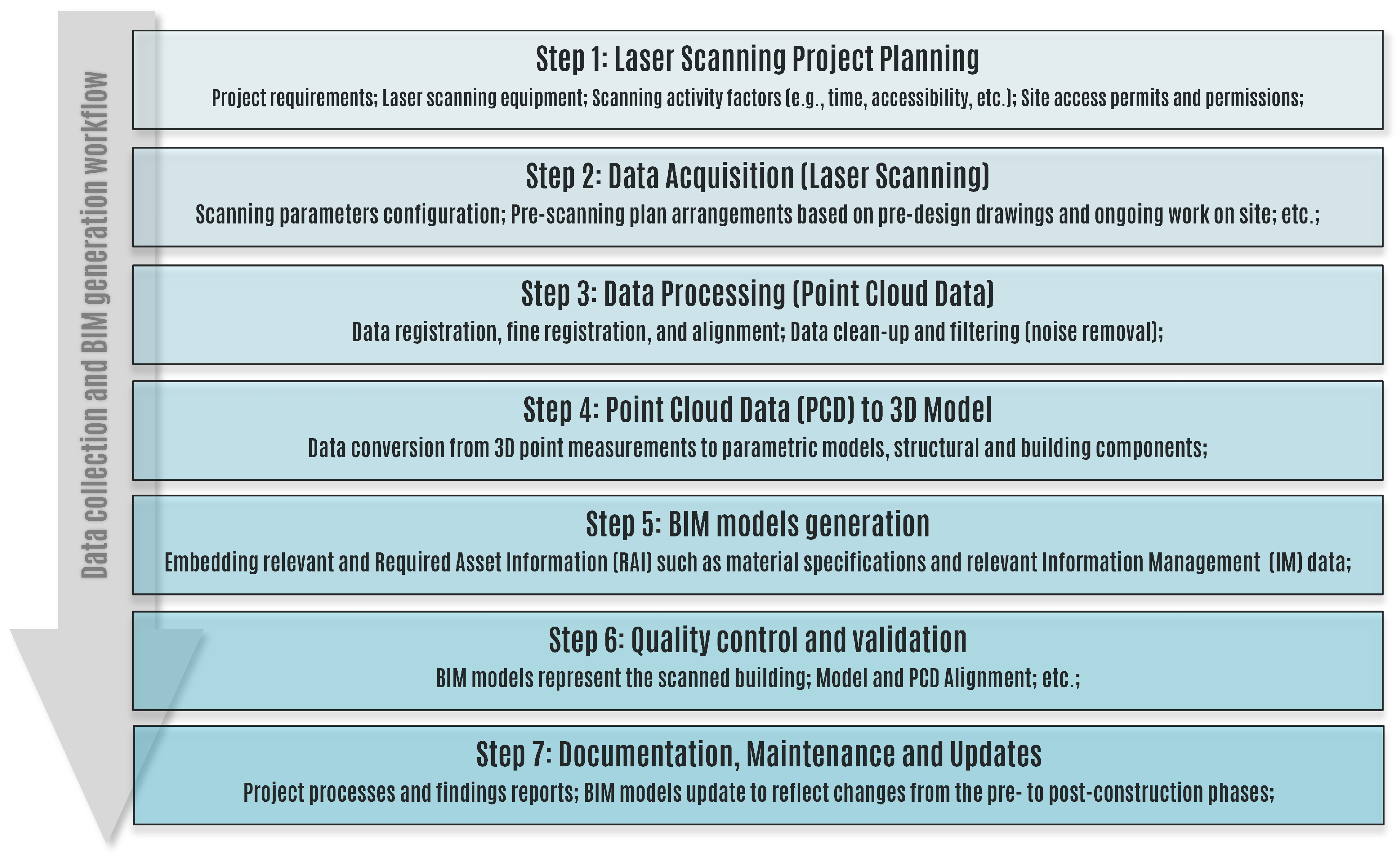
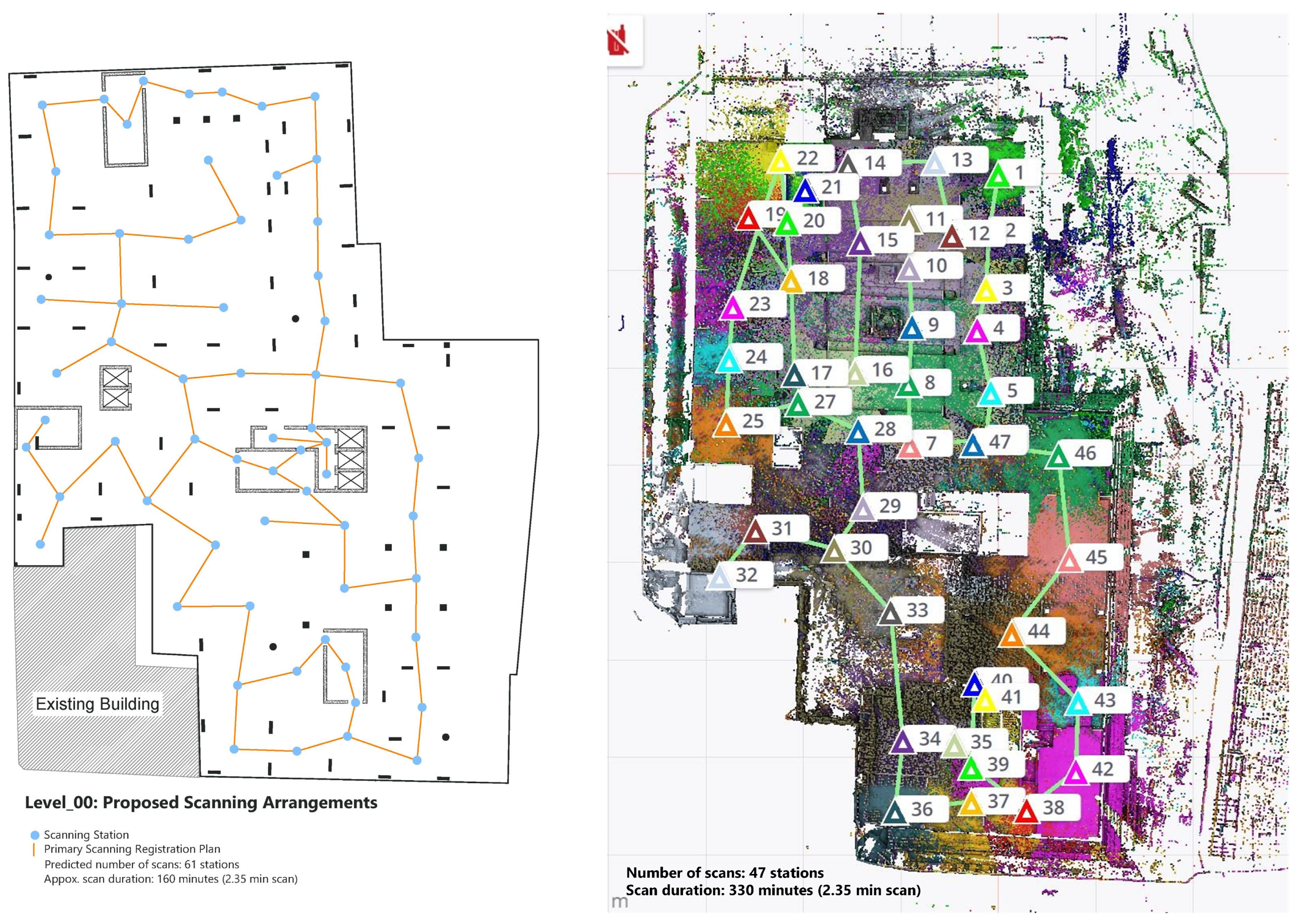


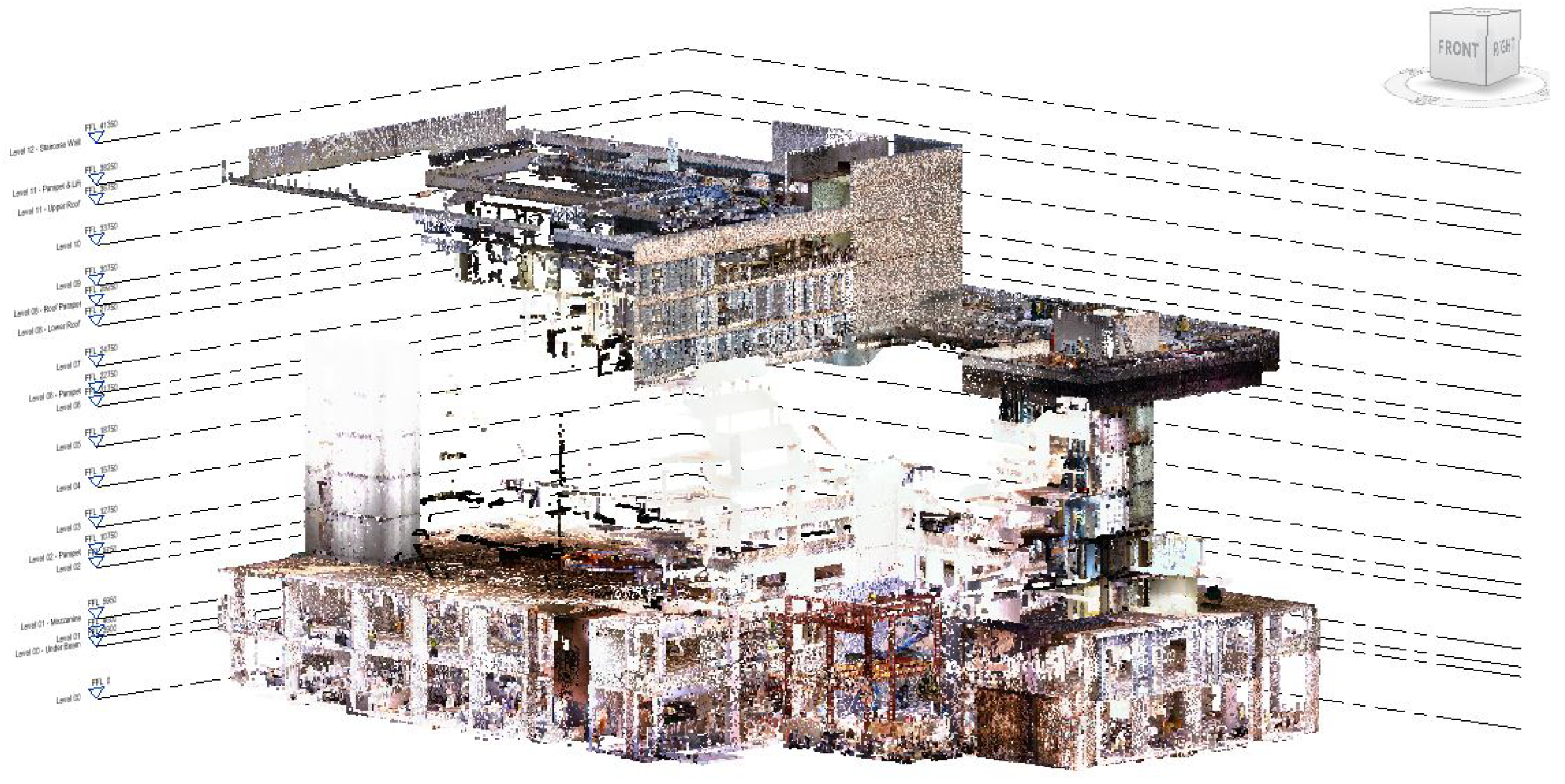
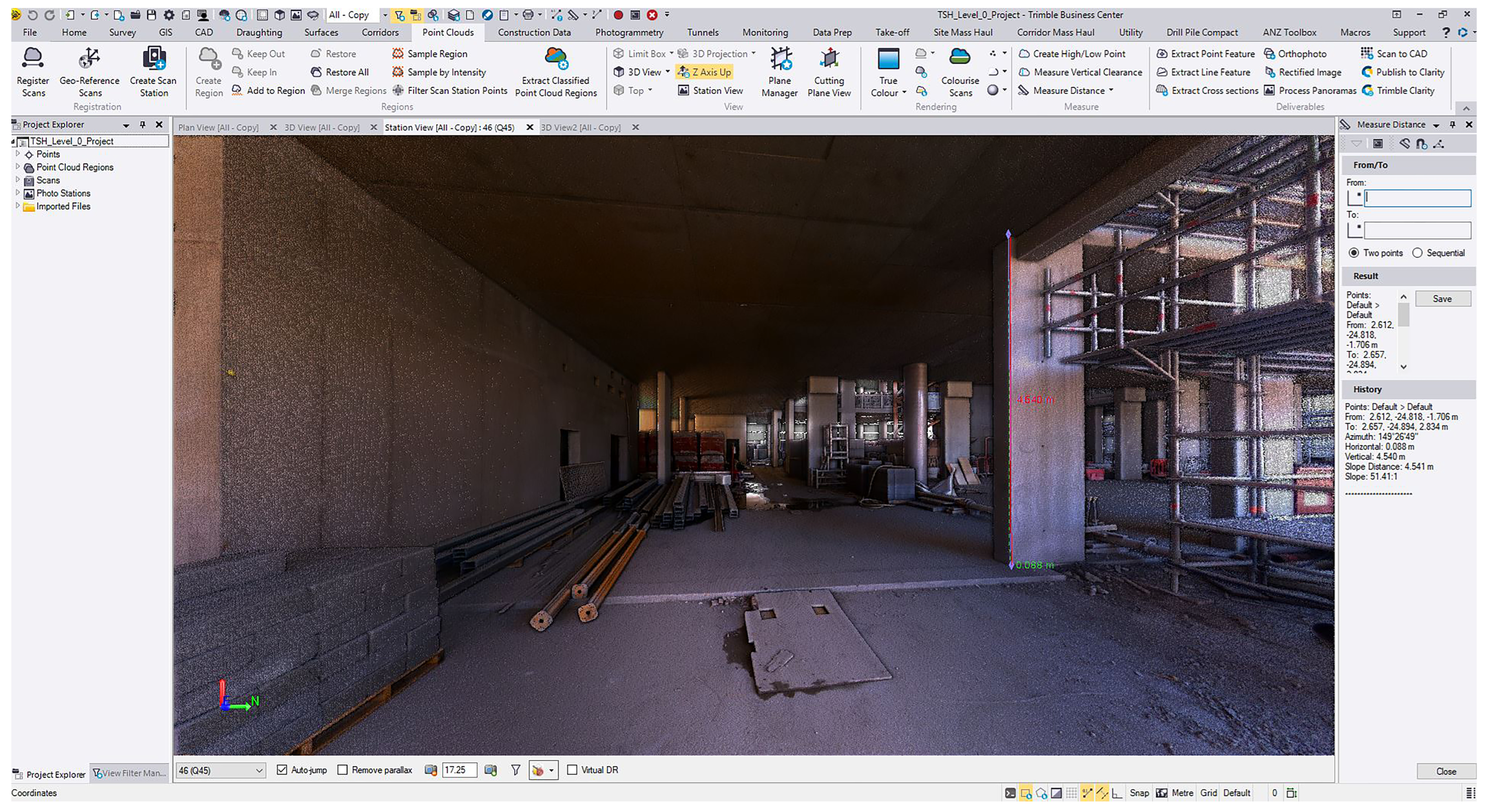

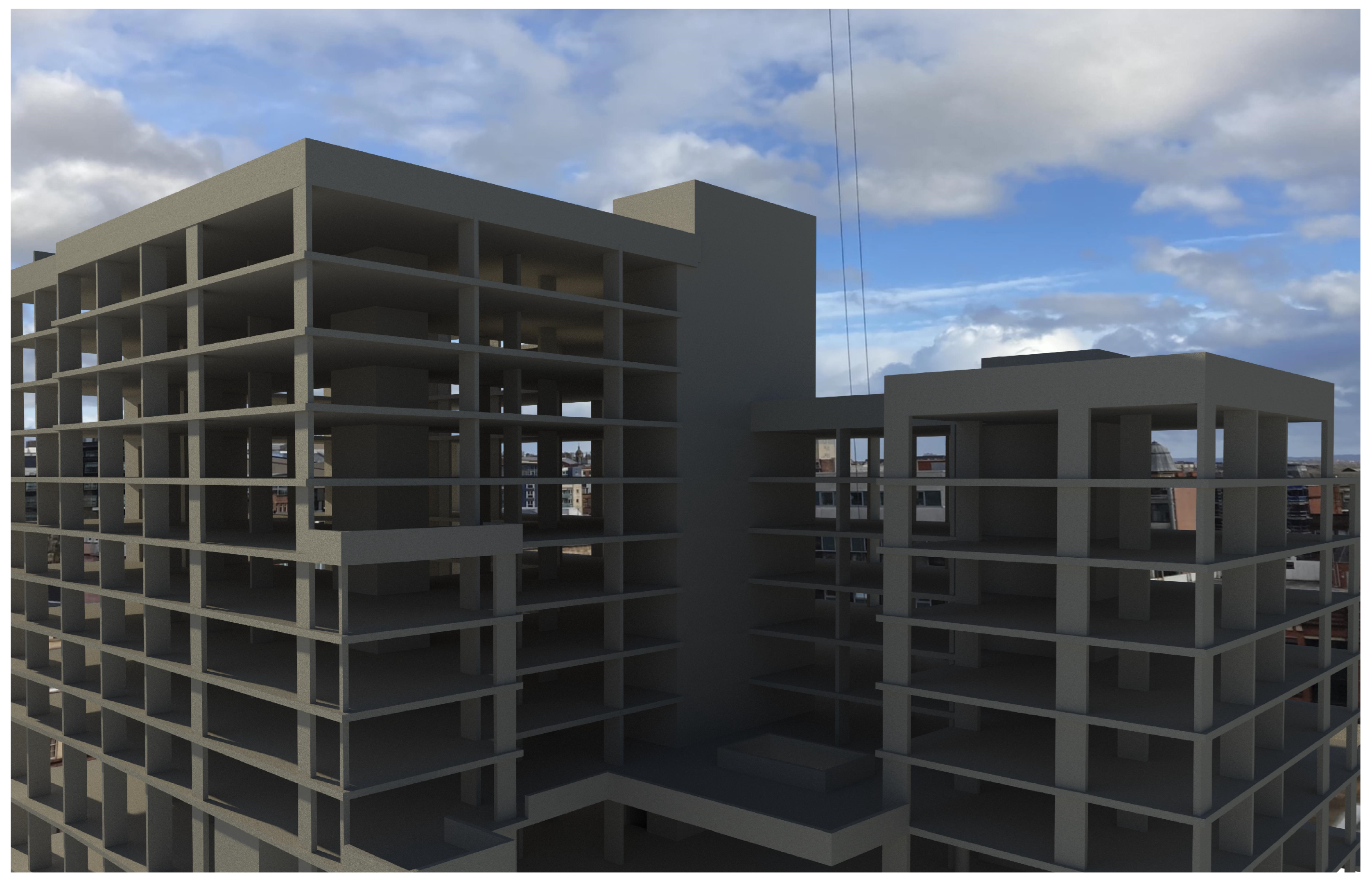
| Specifications | |
|---|---|
| Scan duration | Scanning with images from 2 min 34 s up to 15 min 40 s |
| Field of View | 360° × 282° |
| Range Noise | <2.5 mm @ 30 m |
| Range | 0.6 m to 80 m |
| 3D Point Accuracy | 2.4 mm @ 10 m; 3.5 mm @ 20 m; 6.0 mm @ 40 m |
| Registration | Auto-registration with the last or pre-selected station; Manual registration |
| Accessories | Trimble tablet and Trimble Perspective Software 2022 |
| CPU | Intel Xeon W5-2465X 4.50 G 33.75 MB 16 cores 200 W 3.10 GHz |
| GPU | NVIDIA RTX A5000 24 GB 4DP PCIe x16 |
| Physical Memory | 384 GB usable RAM (DDR5 4800 DIMM) |
| Storage | 6TB SSD (Turbo) |
Disclaimer/Publisher’s Note: The statements, opinions and data contained in all publications are solely those of the individual author(s) and contributor(s) and not of MDPI and/or the editor(s). MDPI and/or the editor(s) disclaim responsibility for any injury to people or property resulting from any ideas, methods, instructions or products referred to in the content. |
© 2024 by the authors. Licensee MDPI, Basel, Switzerland. This article is an open access article distributed under the terms and conditions of the Creative Commons Attribution (CC BY) license (https://creativecommons.org/licenses/by/4.0/).
Share and Cite
Sadeghineko, F.; Lawani, K.; Tong, M. Practicalities of Incorporating 3D Laser Scanning with BIM in Live Construction Projects: A Case Study. Buildings 2024, 14, 1651. https://doi.org/10.3390/buildings14061651
Sadeghineko F, Lawani K, Tong M. Practicalities of Incorporating 3D Laser Scanning with BIM in Live Construction Projects: A Case Study. Buildings. 2024; 14(6):1651. https://doi.org/10.3390/buildings14061651
Chicago/Turabian StyleSadeghineko, Farhad, Kenneth Lawani, and Michael Tong. 2024. "Practicalities of Incorporating 3D Laser Scanning with BIM in Live Construction Projects: A Case Study" Buildings 14, no. 6: 1651. https://doi.org/10.3390/buildings14061651






